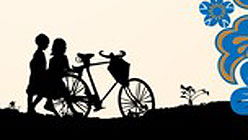Ru Freeman’s On Sal Mal Lane is one of those books you love for revealing a complex subject simply. Freeman explores the years leading to Sri Lanka’s civil war through the lives unfolding on one small street in Colombo, the country’s largest city. The comings and goings on Sal Mal Lane center around the arrival of one charmed family, the Heraths, and the static divisions they encounter among neighbors — Sinhalese, Burgher, Tamil, Muslim — that can be traced back to British rule, which favored the Tamil minority and is reinforced by the ensuing violence against the Tamil people after independence. On Sal Mal Lane these divisions melt away with the type of radical acceptance of which only children are capable.
The prologue in this book is a masterful unveiling of narrative. Freeman writes, “In 1976, on the fifth day of the month of May, a month during which most of the people who lived in the country celebrated the birth, death, and attainment of nirvana of the Lord Buddha, with paper lanterns, fragrant incense, fresh flowers, and prayers mingling with temple bells late into the night, in the remote jungles of Jaffna, in the Northern Province of Sri Lanka, a man stood before a group of youth and launched a war that, he promised, would bring his people, the Tamil people, a state of their own.”
Here lies a powerful axis that Freeman freely exploits, presenting the rumblings of a country on the verge of war as background noise, while directing her unilateral attention to the lives of small, innocent children as that rumbling grows near. The language is beautiful; Freeman writes of the Herath house brimming with talent, good-naturedness and brightness. As the lives of the four Herath children — Suren, Rashmi, Nihil, and Devi — come into focus through descriptions of piano lessons, games of cricket, and shifting alliances, we are lulled and stand in awe at that special halo that surrounds blessed families. Everything is in order; the children are not only obedient, but gifted. Of the eldest child’s piano lessons at the house across the lane, where they are tutored by Kala Niles, a proud Catholic Tamil, Freeman writes: “At his touch, demi-semi-quavers rippled and staccatos clapped with an urgency that, once a week, brought Kala Niles to a state of ecstasy that could only be grounded with the heartbreak of his elongated breves, quivering in the silence of a remembered note and making the tick-tock of her metronome sound like guns.”
The first two parts of the book, however, are filled with fits and stops, the threads of the story getting lost — first in scenes of characters becoming acquainted with one other and then with the expository nature of political complexities being introduced to the children of the lane through question and answer scenes. Freeman dutifully casts her nets, nonetheless, gathering the folds of the story back with thoughtfully placed lines that turn the reader’s eye to a constantly darkening future.
But it is after this lull where the writing, the story, the talent is not to be missed. Under our watch, old racial lines are retraced over the fabric of the peaceful community on Sal Mal Lane and innocence begins to be lost. It starts with two boys: one, a Tamil outcast, the other, a proud Sinhalese — boys who are eager to join the brewing fight against the Tamil Tigers and in misplaced discontent begin to single out the Tamil families on the lane. Devi, the youngest of the Herath children, is the most fearless and unaffected. Her preoccupations lie elsewhere as, increasingly, all the children and adults around her grow nervous and expect the worst. As old Mrs. Joseph tells her son, for example, that they can expect to be under the thumb of the new government for many years to come, she jabs “the thick pad of her right thumb hard onto her left hand.” Devi doesn’t seem to understand the fear and anger Mrs. Joseph feels, but absorbs only the gesture as something she can use on her siblings when she wants to impress them.


